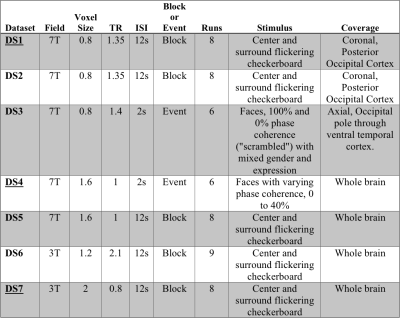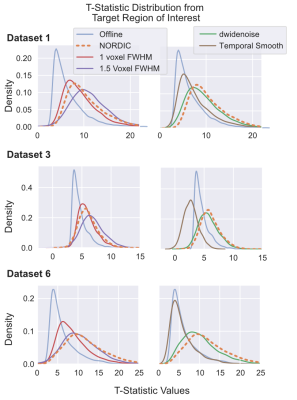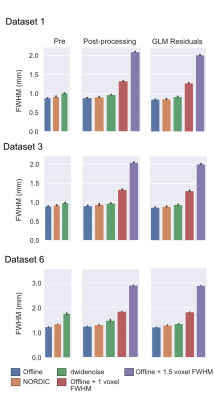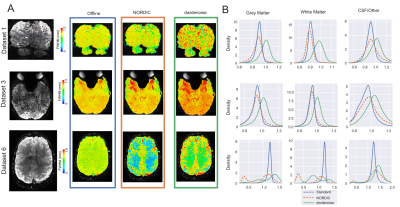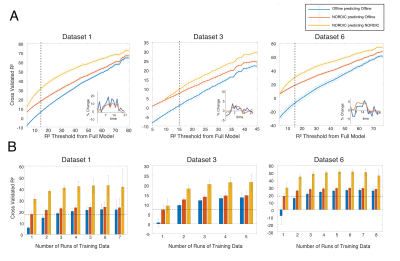2701
Evaluating data precision and signal gains in functional neuroimaging data after NOise reduction with DIstribution Corrected PCA (NORDIC)1Neurosciences, Center for Magnetic Resonance Research, Minneapolis, MN, United States, 2Radiology, Center for Magnetic Resonance Research, Minneapolis, MN, United States, 3Neurosurgery, University of Minnesota, Minneapolis, MN, United States, 4Psychology, University of Minnesota, Minneapolis, MN, United States, 5Medicine, Center for Magnetic Resonance Research, Minneapolis, MN, United States
Synopsis
Functional neuroimaging with gradient echo BOLD has moved to higher and higher spatial and temporal resolutions, which leads to with higher levels of unstructured thermal noise. Here we evaluate the application of the NORDIC method, which suppresses thermal noise, on 7 datasets. We find that NORDIC improve t-values, while not significantly altering fMRI signal characteristics. In addition, a single run of NORDIC data is able to predict held out, original data equally as well as 2 to 3 runs of the original data. NORDIC is a promising new method for dramatically increasing the signal to noise ratio of BOLD imaging.
Introduction
As the neuroimaging field moves towards higher spatial and temporal resolutions, the contribution of thermal noise, which begins to dominate the measured signal, becomes the limiting factor. While a number of methods exist to reduce the impact of structured noise of physiological origin, reduction in thermal noise is sought through the blunt instruments of spatial smoothing or large data collection efforts, which have undesirable consequences and limitations. Here we critically evaluate the performance and accuracy of a recently developed reconstruction method that reduces thermal noise, termed NOise reduction with DIstribution Corrected (NORDIC) PCA1, which uses a patch-based approach to remove signals indistinguishable from zero mean gaussian noise. This evaluation is performed on BOLD functional neuroimaging data acquired at different field strengths, voxel sizes, and sampling rates.Methods
A total of 7 fMRI datasets were considered for analysis (Table 1), with block and event related designs, using checkerboards and faces, respectively. For each dataset we compared results from NORDIC and dwidenoise2, to the data reconstructed in the conventional manner (“Offline”), without denoising. Processing for the 7 datasets was identical and included motion and slice timing correction. Three additional thermal noise suppression methods were applied following processing: spatial smoothing by a full width half max (FWHM) in millimeters equivalent in size to 1 and 1.5 voxels, and temporal smoothing (~10s window). We first examine the gain in T-statistics derived from a generalized least squares approach modeling approach using the canonical hemodynamic response function. Next, we produced estimated task responses at the single-voxel, single trial level, using a finite impulse response model, which seeks to produce an unbiased estimate of the BOLD signal in response to each type of stimulus. We also examined both the overall smoothness in mm (FWHM), derived from a spatial autocorrelation function, as well as the local smoothness in a spherical neighborhood around each voxel. Finally, we use an exhaustive K-fold cross validation approach, with 1≤K<number of runs, to determine how well the estimated unbiased task responses could predict the full timeseries of held-out data, quantified with R2, the coefficient of determination.Results
Results are shown for 3 of the 7 datasets, but are consistent in the remaining 7. In agreement with other work3, we find that NORDIC improves the t-values relative to the Offline (standard recon) data, here shown in within a “Target” Region of interest corresponding to Center > Surround (Datasets 1,6) or Faces > Scrambled (Dataset 3), derived from the Offline data. NORDIC results on T-statistics outperformed spatial smoothing by 1 voxel, temporal smoothing and dwidenoise and are comparable to smoothing data with a kernel equivalent to 1.5 voxels (Figure 1); however, NORDIC’s performance was achieved with negligible increases in global smoothness for NORDIC (Figure 2). Using the local smoothness, reflecting the local spatial autocorrelation around each voxel, we find that the residuals of NORDIC have less smoothness in white matter, a physiologically plausible effect, as local correlations are expected to arise from bulk neuronal, not glial, activity (Figure 3A). NORDIC is not dramatically altering the local correlations, as the distribution of local smoothness estimates following NORDIC tends to resemble Offline data (Figure 3B). Cross validated R2 based on the unbiased models show that NORDIC is not distorting the temporal structure of the data, but in fact is able to better predict the time course of held out data. This is true when predicting based on a single run (Figure 4A), even as voxels that explained more variance in the Offline data are included in the model. A single run of NORDIC has the predictive accuracy of 2 or 3 runs of the conventional data (Figure 4B) and retains advantage even as more runs are used for training.Discussion
While thermal noise is typically minimized by smoothing and/or mass averaging, these approaches are inconsistent with the goals of high-resolution applications, which seeks to precisely characterize the spatial or temporal effects observable at higher field strengths, in individual subjects and/or trials. The NORDIC approach is very promising for data of this type, as it increases statistical measures and reduces between run error with negligible effects on spatial precision. Here we show that this is true for both 3 and 7 Tesla imaging, as well as a variety of TRs and voxel sizes. While the t-statistics for NORDIC are similar to that of 1.5 voxel smoothing or dwidenoise, NORDIC data does not show meaningful increases in estimated smoothness. Most importantly, cross-validation analyses suggests that NORDIC is leaving ground truth signal characteristics untouched, thereby improving the predictive accuracy of unseen data. Cumulatively, we find that the NORDIC method shows significant improvements for a variety of fMRI acquisition protocols, including HCP-like approaches, and particularly for cutting-edge high spatial and temporal applications.Conclusion
NORDIC performs well across a diverse array of acquisitions and task designs. Importantly, NORDIC offers the promise of substantially reducing the scan time, by as much as a factor of 3, alleviating participant burden in high-resolution acquisitions or clinical research. The demonstrated improvements for sub-millimeter gradient echo BOLD are expected to transfer to even more SNR-starved methods, such as spin echo BOLD or VASO, though this remains to be experimental verified.Acknowledgements
This work was supported by NIH grants: U01EB025144 (K.U.), P41 EB027061 (K.U.), P30 NS076408 (K.U.) and RF1 MH116978 (E.Y.), and RF1 MH117015 (G.G.)References
1 Moeller, S. et al. NOise reduction with DIstribution Corrected (NORDIC) PCA in dMRI with complex-valued parameter-free locally low-rank processing. NeuroImage 226, 117539, doi:10.1016/j.neuroimage.2020.117539 (2020).
2 Veraart, J. et al. Denoising of diffusion MRI using random matrix theory. NeuroImage 142, 394-406, doi:10.1016/j.neuroimage.2016.08.016 (2016).
3 Vizioli, L. et al. A Paradigm Change in Functional Brain Mapping: Suppressing the Thermal Noise in fMRI. BioRxiv, doi:10.1101/2020.11.04.368357 (2020).
Figures
